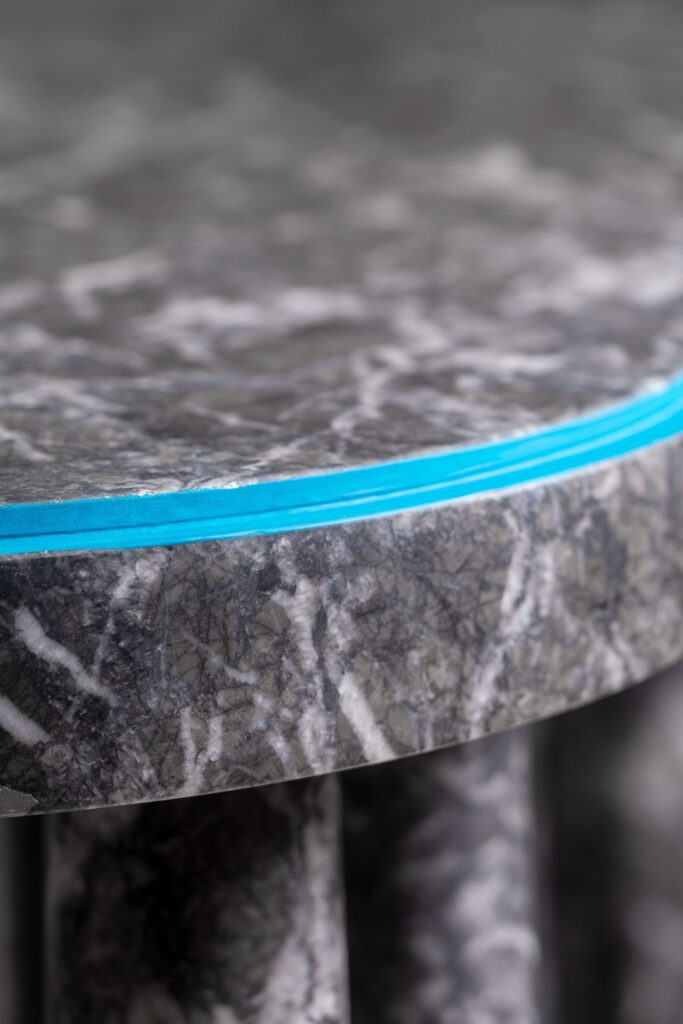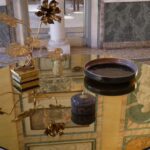Marmaros
La bellezza del marmo tra antico e design
«My works have always been born from the interest and curiosity I have for the material and the possible ways of working with it; to then find solutions often even to the limit, I would say. Great attention must always be paid to the choice of materials with which an object will be made, since a very delicate relationship with the form is established. Technological innovation represents one of the fundamental aspects for the designer’s work, but it must not lead to the exasperation of technique to the detriment of other aspects.»
This quote from Angelo Mangiarotti, architect and designer, explains the birth of the successful Eros and Incas series, made of marble and pietra serena and created by Skipper in the Seventies.
These furnishings constitute a conspicuous core of the items proposed at the FineArt by Di Mano in Mano event, at the Cambiago exhibition spaces, from 23 September to 1 October. In the exhibition dedicated to the multiple uses and processes of marble, from ancient through design to contemporary pieces, Mangirotti holds a place of honour, as the creator of the furnishings which are characterized as real experiments with marble .
For the architect, the stone material allows for openness to new experiments, especially in the structure of furniture; it is specifically chosen because it is the material that best lends itself to the creation of the object itself. Mangiarotti carefully studied the aesthetic rendering of the joints of the blocks that make up the tables, but he also analyzed the physical characteristics of the material, which with its specific weight allowed him to create tables whose stability is guaranteed by gravity.
Marble is therefore chosen both for its grandeur and aesthetic refinement, but also for its physical peculiarities, functional to the creation of tables as designed by the designer.
Mangiarotti himself, remaining faithful to the concept of design as products linked to a more massive production, with the creation of the successful Eros series, led to a real mechanization in marble processing. If until recently many manual interventions were necessary, these were almost completely eliminated thanks to the development of equipment specially created for the occasion.
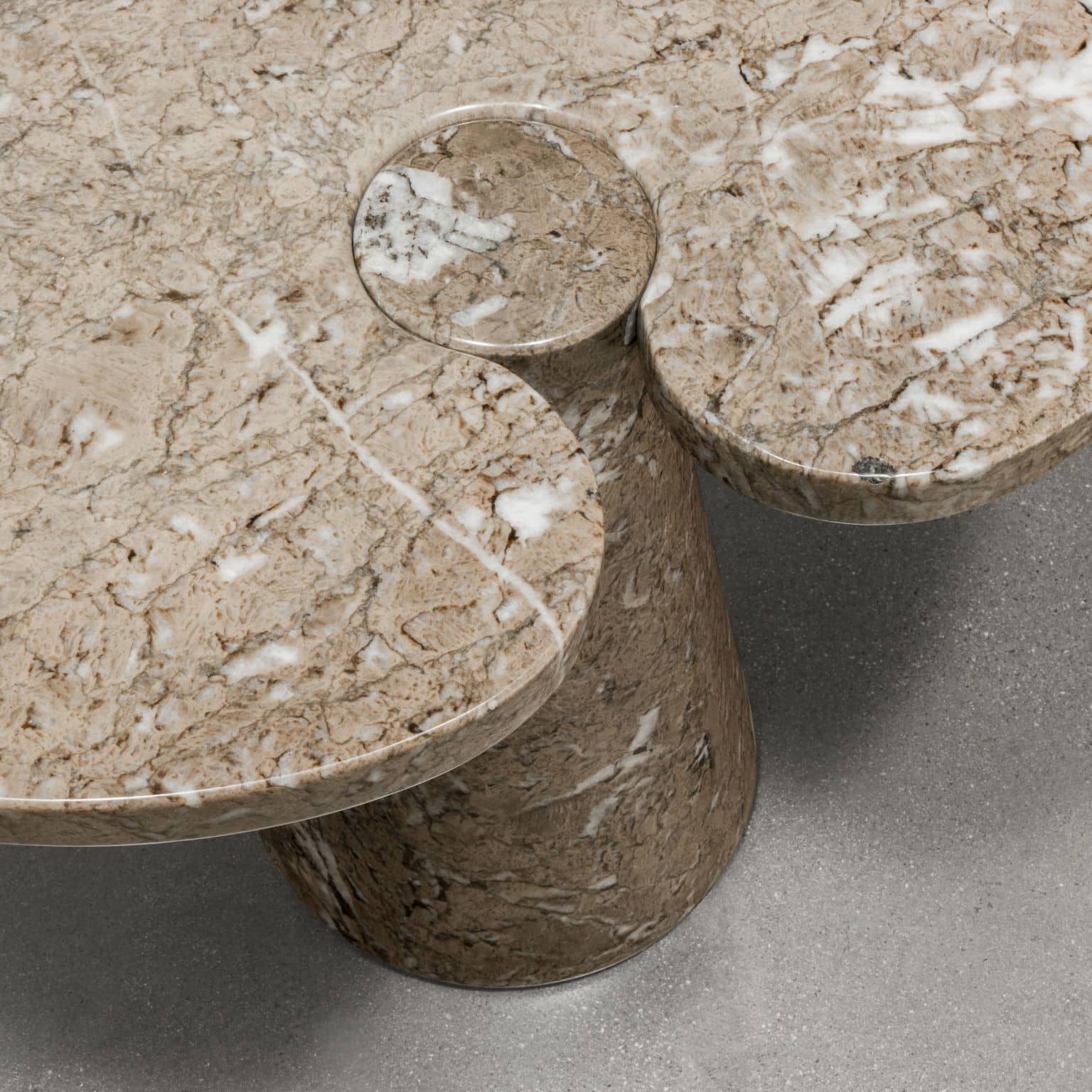
Mangiarotti’s experimentation with marble continued in the following decades. In fact, the M4 table dates back to the 1980s, in which marble is used only for the central balustrade, while the top is made of glass, creating a lighter piece of furniture both literally and visually, through the transparencies of the top.
«In my projects, I have always tried to let people’s needs participate in the definition of the work. I would say that the fundamental starting point for designing a design object lies in the usefulness it has for people. An object that is not born from a necessity cannot even be considered as belonging to this category, design.»
Angelo Mangiarotti
The use of marble in more recent times had already been addressed in recent times by other architects.
With the advent of industrialization and, even more so, with the chemical discoveries of the twentieth century, the world of objects and furnishings was completely transformed. Especially in the 1950s and 1960s, the production of furniture increasingly saw the use of plastic materials, which were in great demand both for being synonymous with that much-desired innovation, but also for their affordability and therefore the possibility of entering homes. of the masses. In the previous decades, in fact, the way of conceiving the domestic dimension of one’s homes had completely changed and the possibility of furnishing homes had now become necessary, starting from the emerging working class, with furniture and objects that were at the same time economical, functional and pleasant in appearance. This type of material in fact allowed the opening up to new experiments also in the aesthetic and shape fields, not only with new visual effects, but also of the structure itself.

Within this panorama dominated by a completely new production and which catalyzes a large part of the market, some architects and designers established themselves who instead still use a noble and ancient material such as marble.
Starting precisely from the definition of design, marble was no longer chosen purely for its aesthetic qualities, but also for its functionality. The stone material, with a view to usability within an industrial production, was chosen for its intrinsic characteristics of specific weight and stability, allowing, through a careful design phase, the creation of new furnishings.
Specially chosen by designers because it is the material that best lends itself to the creation of the object itself.
A clear and early example in this regard is the famous Arco by Castiglioni for Flos (1962), for which the choice of marble was not decided from the beginning, but almost forced by the structure of the lamp itself. The heavy block in fact acts as a counterweight to the telescopic arm at the end of which the reflector is located, providing great stability.
During the same decade the use of marble no longer became casual and occasional, but was characterized as a choice desired by various designers, no longer relegated only to a decorative part, but itself as a structure.
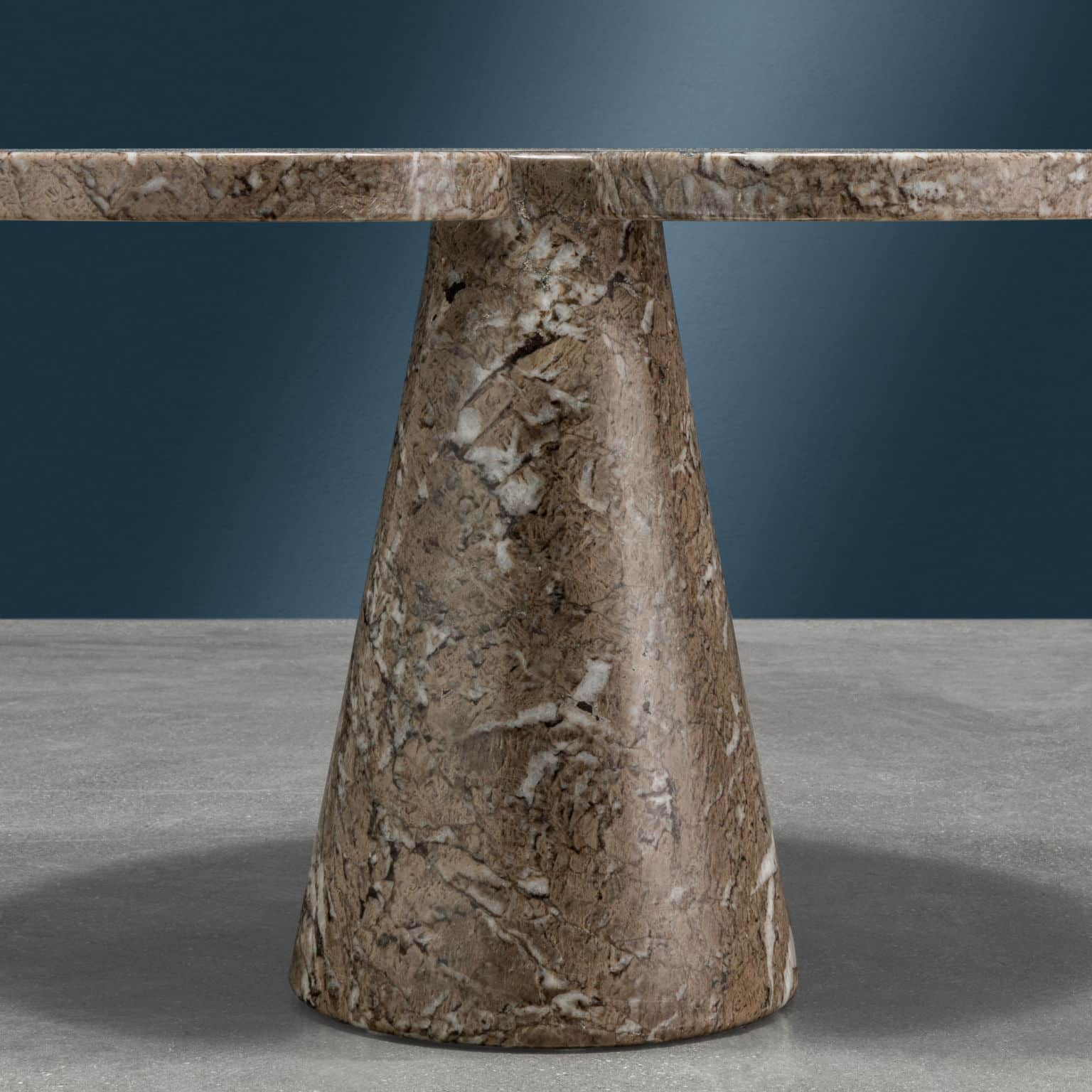
«We are not interested in the mediocre, we know the beautiful, we go in search of the sublime».
Carlo Scarpa
The examples of Carlo Scarpa, one of the greatest Italian architects, are further evidence of this.
The Delfi table was designed by Scarpa in 1970, revising a rationalist model created in the 1930s by Marcel Breuer. This furniture is made up of two monolithic marble bases that support the rectangular top of the same material, fixed together with brass bushings and marble pins. The table is conceived as an architectural element, with its powerful grooved bases, and the use of marble only increases this perception. The same concept is the one behind the Samo table, also produced by Simon starting from 1970.
In reality, the use of marble has its roots in ancient times.
Marmaros, “shining stone”, in ancient Greek indicated any stone that could be polished by polishing.
In ancient times, marble was chosen for its aesthetic qualities, but also for its resistance and longevity. Sought after by sculptors, the natural hardness of the material and the difficulty in correcting errors require particular attention not only in the execution phase, but also in the design phase. Even before that, the artist must know how to choose the marble block properly, to avoid the formation of cracks or breakages.
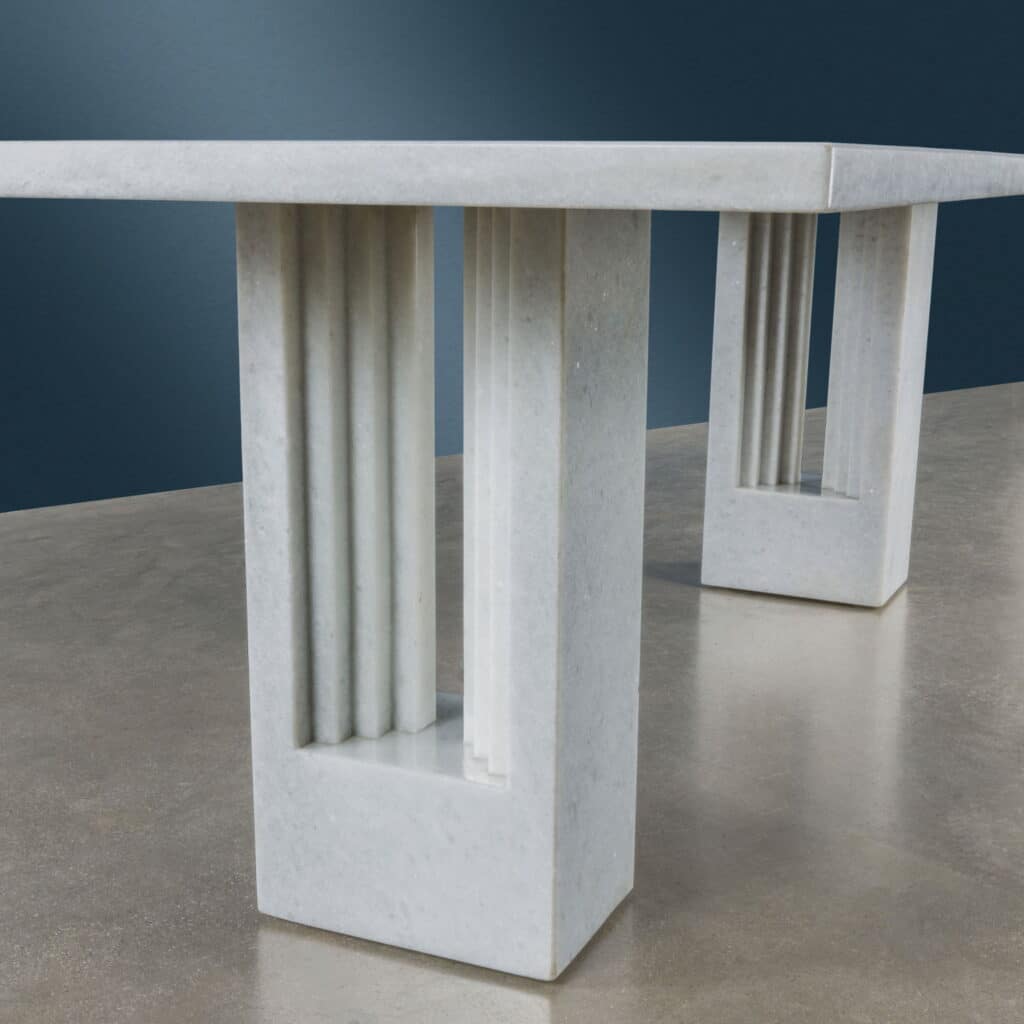
In ancient times, in the Renaissance era, as well as in the Baroque era and up to the 19th century, marble was sought purely for its aesthetic qualities. Widely used in the making of statues, this material is known to be the favorite of many well-known artists. One cannot fail to mention Michelangelo Buonarroti and his numerous sculptural devices, which demonstrate the ability to shape the material, making the powerful figures emerge from the rough block. Again, later, Gian Lorenzo Bernini, a true genius in the treatment of marble which he transformed giving an absolutely mimetic rendering with reality.
But in ancient times marble was also widely used to decorate furnishings, to embellish them: the difficulty in extracting, transporting and processing the material make it an expensive product, which only the wealthiest clients can afford.
The presence of marble on the furniture confirms the high workmanship and refinement of these accessories.
Marble was used above all in the creation of floors; rarer but still known are examples of coffers in which the stone material is also used to embellish the front and sides.
A true status symbol, marble was also sought after for its aesthetic characteristics, thanks to the numerous variations and colours. Furthermore, the marble slabs are often placed next to each other so that the veins form geometric designs and mirrors, increasing their refinement.
But in ancient times marble also had a real scientific value. With the rediscovery of the Pompeian excavations and the phenomenon of the Grand Tours, stone tables are in great demand, whose tops made of committed marble present a sample that satisfies the buyer’s desire for culture. Among the most prolific workshops is the Opificio presided over by Alfonso Cavamelli, to whom the majestic table on display is attributed. Even with great accuracy in the aesthetic rendering, thanks to a complex system of ellipses that form the lozenges within which the marbles are housed, the circular surface presents itself as a real catalog of marbles and semi-precious stones, a selection of stone materials sought after for their beauty and demonstration of culture, therefore once again to underline the social status, in this case of a learned man of the Enlightenment.
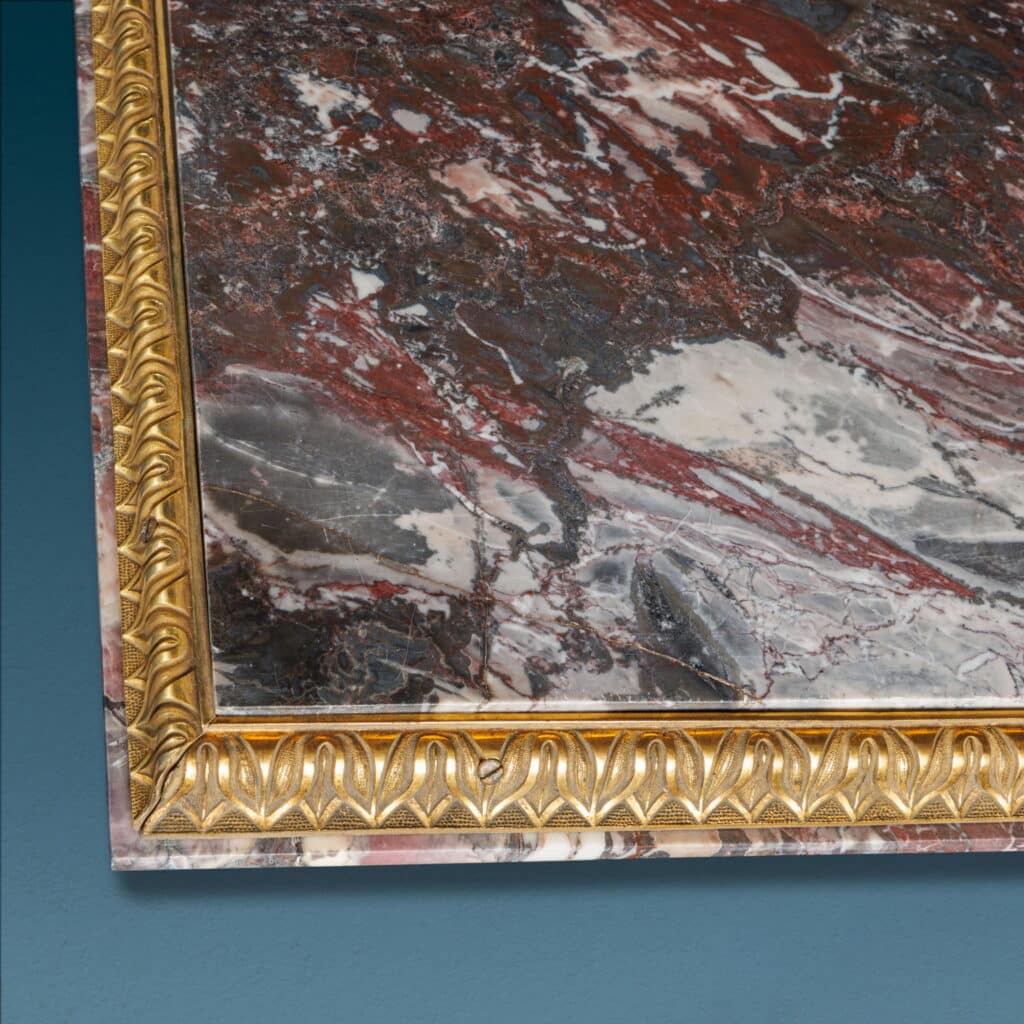
Marble continues to be a material appreciated and used by designers today, like the works proposed and created by studiointerno.
Founded by Andrea Ghisoni, studiointerno pursues a project idea that arises from the intersection between the essentiality of the sign, the brightness of the shapes and the nobility of the craftsmanship.
Single-material furnishings capable of configuring themselves as small architectures, which interact with the light of the surrounding environment, generating plays of chiaroscuro. The elements of architecture make a leap in scale to become the structure and decoration of furnishings characterized by a strong identity.
The research into materials and finishes enhances the product, giving it uniqueness and making it a precious element.
The Mirage collection, represented in the exhibition by the coffee tables and centerpieces, arises from the monolithic materiality of stone. Form and function coincide, creating a no-frills element, which arises from the subtraction of matter. The solids and voids alternate and create shades of light thanks to the juxtaposition of the decorations.
The Bogdan console is born from a single block of marble. A single-material furnishing accessory, characterized only by a single color line that defines its perimeter and shape.
The cones at the base, arranged in a circular manner to create a unitary element, support the surface which acts as a uniting element of what raises it. The detail of the workmanship on the edge embellishes and completes the top, creating, together with the cones, plays of light and dark.
